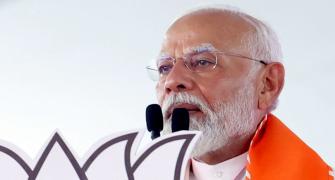Is the average Indian household moronic? We normally tend to believe that the rational economic agent is aware of the savings alternatives and is willing to substitute instruments in a manner such that returns are maximised, which is what economic theory also assumes.
Therefore, whenever we talk of interest rates, we assume that when interest rates fall, bank deposits would decline as savers would move away from fixed deposits with banks to more remunerative instruments such as capital markets or small savings.
Economic intelligentsia also adds another dimension in talking about real returns where adjustments are made for inflation, or going ahead one step further, expected inflation.
However, if you look at the trends in the savings pattern of Indian households, a different pattern emerges. The Indian saver, in fact, typically does not seem to be quite as perspicacious as our textbooks assume him to be.
The interest rate on a bank deposit with a tenure of one to three years has dropped from 9 per cent in FY00 to 4.6 per cent in FY04. But the share of bank deposits in total financial savings actually increased from 35.1 per cent to 42.8 per cent during this period.
Quite clearly, deposit holders are not really sensitive to interest rate changes. The reasons are not difficult to guess. Tradition and lethargy combine to retain a shine on declining deposit rates because households are not mobile when it comes to bank deposits.
A person banking with, say, a local bank does it out of convenience and tradition; and due to this acquired familiarity is loathe to shift to other banks or other avenues of savings.
In fact, even the growth of private sector banks did not replace existing deposits in public sector banks but only cornered a larger incremental share in deposits growth.
A second surprise in the profile of Indian savings is that despite all the noise that has been made by the government and high level committees on lowering the interest rates on small savings and provident funds, their share has actually fallen over the years.
The share of provident funds has fallen from 22.8 to 13 per cent, while that of small savings has been constant in the 17 to 18 per cent range in the past five years.
This means that while households do diversify their portfolios, they strike a balance between returns and liquidity. Retaining higher interest rates on provident funds does not really increase savings in this zone.
The third observation is even more striking. While we do have a large number of people who invest in the secondary segment of the capital market and make good returns, interest in the primary segment has been tardy with the share falling from 7 to under 2 per cent during this period.
This means that the typical household is generally risk-averse and does not seem to be too inclined to the high returns of 25 to 30 per cent delivered by the Nifty or Sensex.
Going further, it also appears that the money in the stock market is more of a revolving nature or unaccounted money that does not feature in the savings portfolio profile of households.
In fact, barring the period 1991 to 1993, when the now "infamous" boom took place in this market when its share rose to a double-digit number, the capital market has not been an attractive preferred avenue for deployment of savings in the country.
The fourth interesting aspect of the savings profile is that currency is still very important for households and its share has tended to rise over the past 15 years or so with an average of over 10 per cent of savings being held in this form.
And considering that currency does not earn any return, it does reveal that the typical Indian saver is not too discerning about maximising his returns on wealth. He looks at convenience and liquidity that currency provides better than any other instrument.
Insurance products have become important in the last quinquennium with around 15 per cent of savings being routed into this channel. Insurance products are attractive despite low returns because of the tax benefits and the block returns received that more than compensate for the apparent low return.
Life insurance gives one the psychological assurance of a lump sum return, and hence, even though the insurance to income ratio is low in India, it is still fairly high in the savings profile of households.
Last, non-banking deposits have virtually faded after the non-banking financial corporations meltdown and the subsequent disappearance of a number of these companies.
The lessons learnt are that first, households are not as discerning as we make them out to be. This checkmates the tenets of economic theory that assumes rational human behaviour.
Second, people are generally risk-averse because none of the so-called high-risk avenues have reassured the savers over time. Third, we do make much ado about the provident fund interest rates, and last, currency notes still have their own glitter, zero returns notwithstanding. And also be wary of all talk of real returns -- they may not really matter to you and I.
The writer is chief economist, NCDEX Limited






